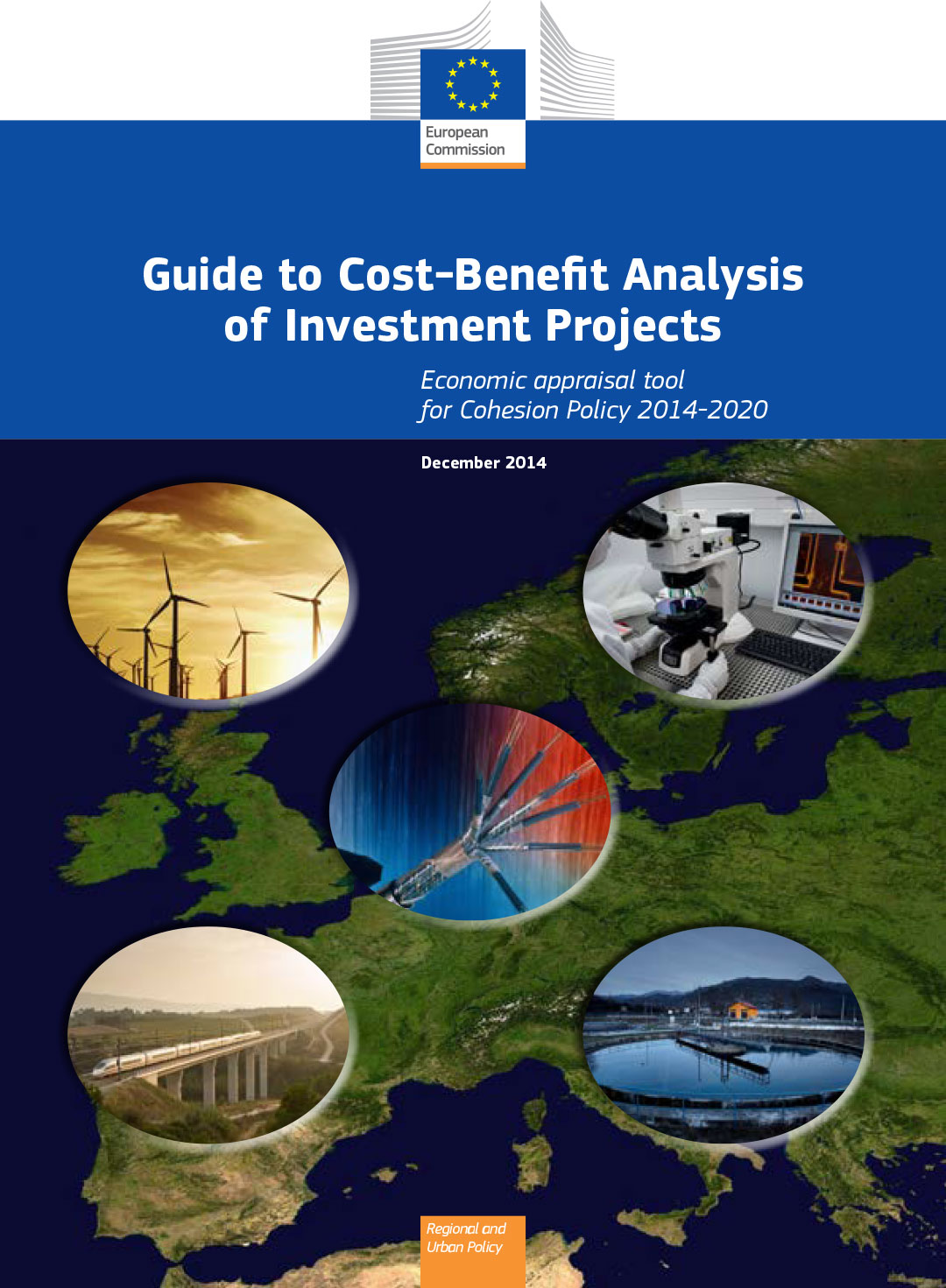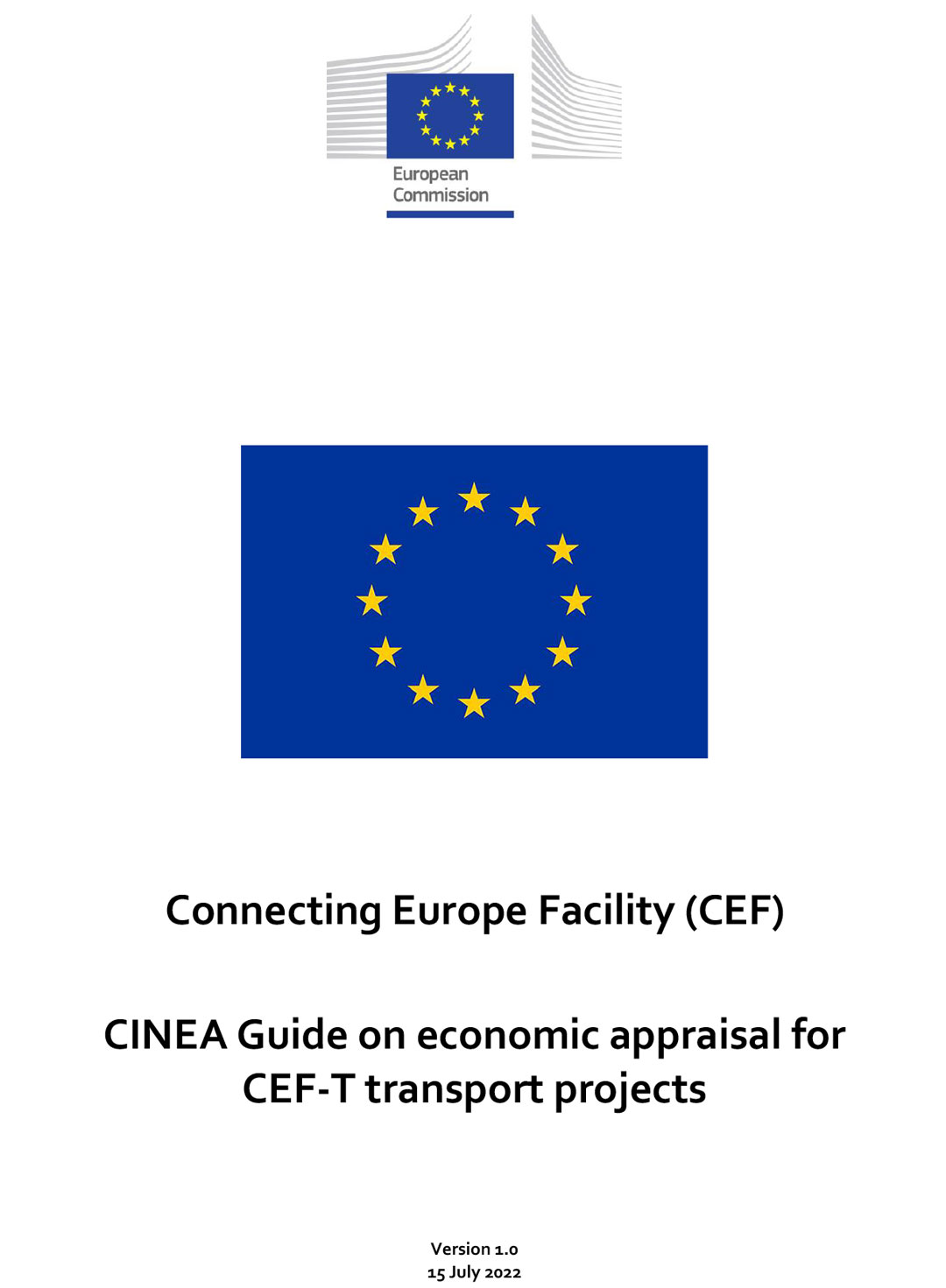CBA AND SOCIOECONOMICS
COST-BENEFIT ANALYSIS
Cost-benefit analysis (CBA) is a method used to understand if the benefits of a public project will outweigh the costs for the community. It compares all the positive and negative effects with respect to a baseline scenario (the situation without the project). It not only takes into account the project construction costs, but also assesses all the other effects, both positive (such as time savings, reduced pollution or improved safety) and negative (such as the impact on the environment or disruption during construction). The process results in monetary values showing whether or not, overall, the project will create value for the community.
The CBA for the Strait of Messina Bridge was updated in 2024 following European and Italian guidelines and took into account the direct and indirect costs and benefits of the project. The following guidelines were applied:
- Operational guidelines for assessing investments in public works – railway sector (26 October 2021)
- Operational guidelines for assessing investments in public works – highways sector (7 July 2022)
The analysis also complies with the criteria set out in the document “EU Grants: CINEA* Guide on economic appraisal for CEF-T Transport Projects”, which must be met to qualify for grants under the Connecting Europe Facility.
* CINEA: the European Climate, Infrastructure and Environment Executive Agency.
COST-BENEFIT ANALYSIS
Cost-benefit analysis (CBA) is a method used to understand if the benefits of a public project will outweigh the costs for the community. It compares all the positive and negative effects with respect to a baseline scenario (the situation without the project). It not only takes into account the project construction costs, but also assesses all the other effects, both positive (such as time savings, reduced pollution or improved safety) and negative (such as the impact on the environment or disruption during construction). The process results in monetary values showing whether or not, overall, the project will create value for the community.
The CBA for the Strait of Messina Bridge was updated in 2024 following European and Italian guidelines and took into account the direct and indirect costs and benefits of the project. The following guidelines were applied:
- Operational guidelines for assessing investments in public works – railway sector (26 October 2021)
- Operational guidelines for assessing investments in public works – highways sector (7 July 2022)
The analysis also complies with the criteria set out in the document “EU Grants: CINEA* Guide on economic appraisal for CEF-T Transport Projects”, which must be met to qualify for grants under the Connecting Europe Facility.
* CINEA: the European Climate, Infrastructure and Environment Executive Agency.
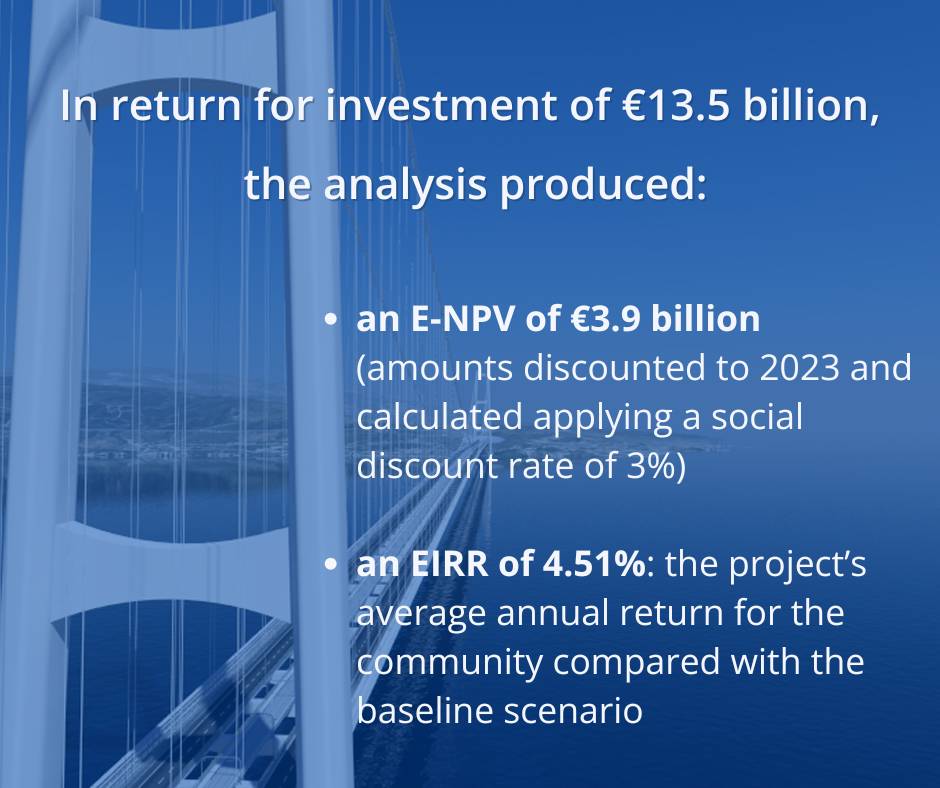
KEY CONCEPTS AND RESULTS
In the CBA, the “Benefits” represent all the advantages that the project will deliver for the community over time, such as time savings, reduced pollution and improved accessibility. The “Costs” represent all the resources used to build, operate and maintain the infrastructure. They are not just based on public spending, but include any negative impacts on the environment, on the local area and on the social fabric. All the effects taken into account are then converted into monetary values to enable objective comparison. A synthetic indicator that is key to the CBA is the Economic Net Present Value (E-NPV), which measures the net present value of the benefits generated by the project after deducting the costs. A positive E-NPV indicates that the investment creates added value for society.
Another important metric is the Economic Internal Rate of Return (EIRR), which shows the average annual return on the investment for the community. The higher the EIRR, the greater the economic benefits of the project compared with the baseline scenario. The results show that construction of the Strait of Messina Bridge will make a major contribution to improving community wellbeing. There will be significant benefits for Italy as a whole, with improvements of both an economic and environmental nature.
Based on an investment cost of €13.5 billion, the analysis has resulted in:
- an E-NPV of €3.9 billion (amounts discounted to 2023 and calculated applying a social discount rate of 3%)
- an EIRR of 4.51%. The Economic Internal Rate of Return is the rate that, by taking into account the time distribution of the “Benefits” and “Costs” of a project, measures the average annual return. The higher the EIRR, the greater the return on investment and thus the benefits for the community.
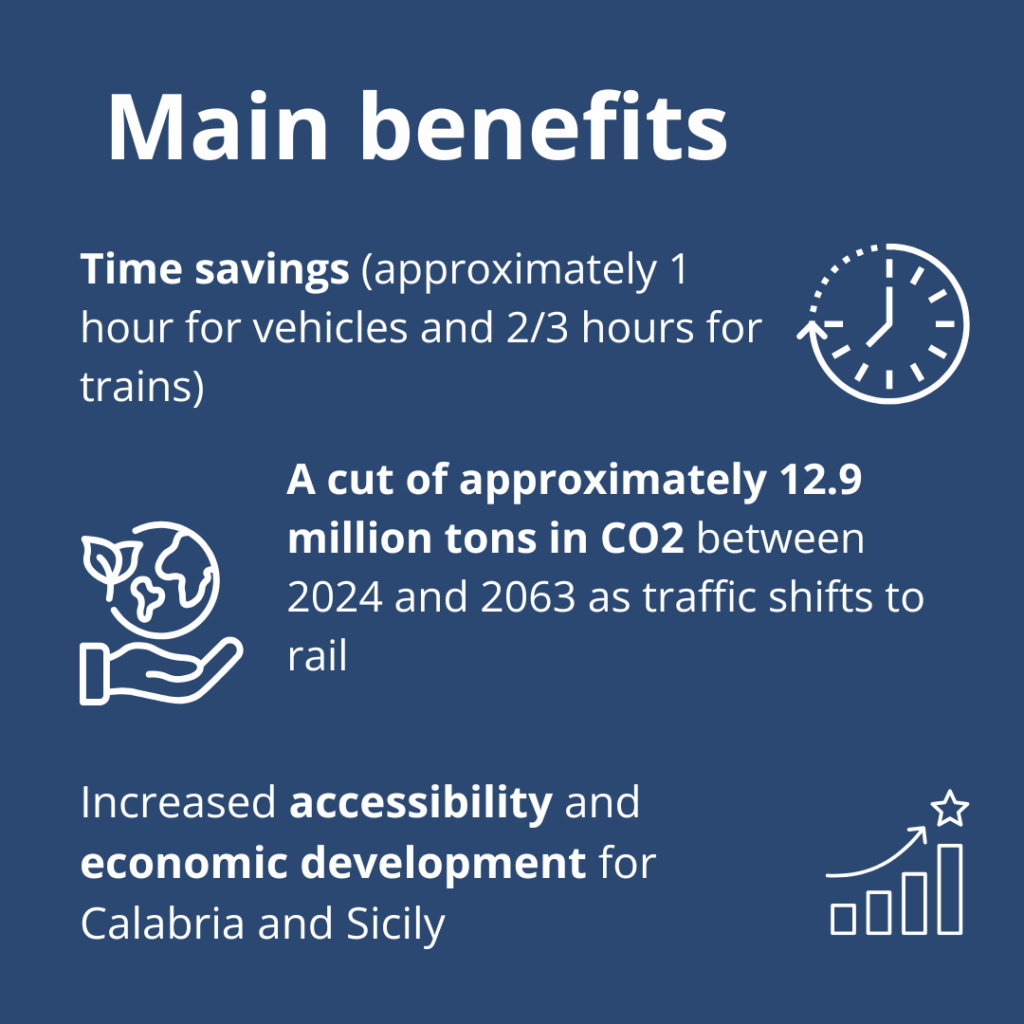
BENEFITS: TIME SAVINGS AND REDUCED EMISSIONS
The main socioeconomic benefit expected regards time savings that will cut the time needed to travel between Sicily and the mainland.
The Bridge will guarantee average crossing times of approximately:
- 15 minutes for rail services between Villa San Giovanni and Messina Centrale, compared with the current 120 minutes for passenger trains and at least 180 minutes for freight trains; and
- 10/13 minutes for road traffic (between the Santa Trada and Giostra junctions), compared with the current 70 minutes for cars (San Francesco Terminal) and 100 minutes for heavy goods vehicles (Tremestieri Terminal).
The opening of the Bridge will see a major modal shift to rail, with medium- to long-range maritime transport transferring to rail and passenger transport to high-capacity rail. This modal shift will cut CO2 emissions by approximately 200,000 tonnes a year.
Overall, it is estimated that, in the period between 2024 and 2063, this modal shift to rail will cut CO2 emissions by approximately 12.8 million tonnes, after taking into account the approximately 2 million tonnes of CO2 generated during the construction phase. In conducting the economic assessment, the estimate of the benefits linked to lower CO₂ emissions was prudently calibrated to take into account expected improvements in terms of the energy efficiency of vehicles and fuel, including those in the maritime sector.
OTHER SOCIOECONOMIC STUDIES
THE COST OF SICILY’S INSULARITY
In 2020, a study, “An estimate of the costs of Sicily’s insularity”, was carried out by Sicily Regional Authority’s Public Investment Evaluation Unit (NVVIP) and the Office of Statistics and Economic Research within Sicily Regional Authority’s Department of Economic Affairs, with the support of the Prometeia research institute. The main results showed that insularity, represented by the island’s separation from mainland Italy, leads to further specific issues of an economic, transport-related, environmental, social and demographic nature. This means that the island is at an objective disadvantage compared with mainland regions, as confirmed by the large volume of literature on the subject. An econometric study has quantified the cost of Sicily’s insularity at approximately €6.54 billion, equal to 7.4% of the region’s GDP (at present values in 2018). Construction of the Bridge will help significantly in reducing this cost.
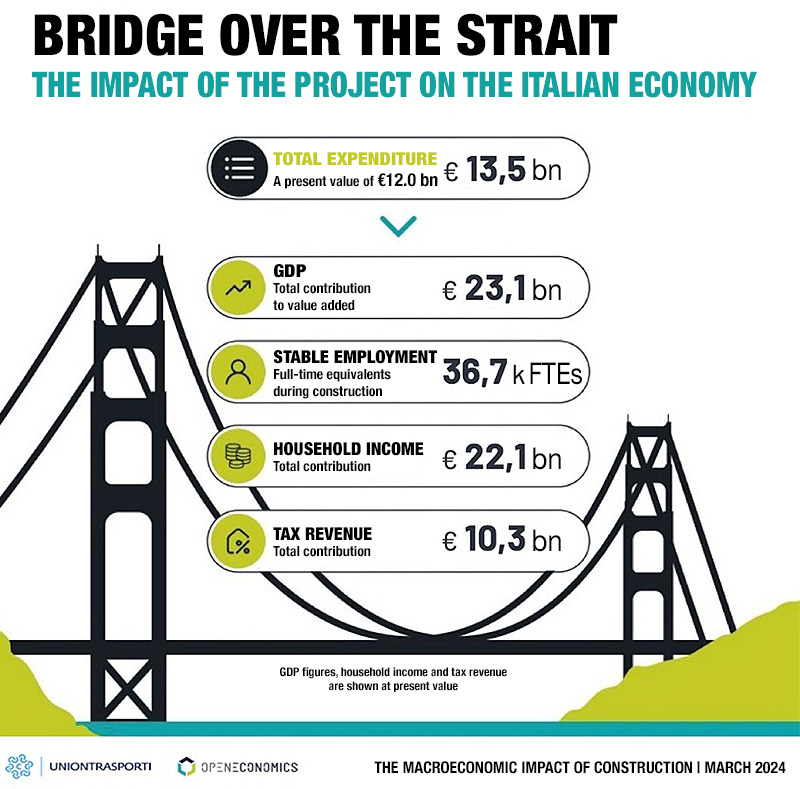
ANALYSIS OF THE SOCIOECONOMIC IMPACT OF CONSTRUCTION
In 2024, Open Economics conducted a study of the socioeconomic impact of construction of the Strait of Messina Bridge, in collaboration with Unioncamere Sicilia, Uniontrasporti and Palermo and Enna Chamber of Commerce and with the support of Sicily Regional Authority. The key results showed that, in providing a stimulus for the Italian economy, the investment of €13.5 billion would boost GDP by a total of over €23 billion, with the expenditure having a multiplier effect of 1.71. The data on which the study was based – provided by Uniontrasporti, Stretto di Messina SpA, Istat and the Bank of Italy – were fed into a Social Accounting Matrix (SAM), in keeping with international valuation practices. In this initial stage, the study assessed the effects during construction, evaluating the impact of expenditure on construction of the infrastructure in terms of direct effects and spillovers for the Italian economy as a whole.
€23.1 billion of GDP will be generated: €5.9 billion (equal to 26% of the total) generated directly due to expenditure on goods and services in the sectors involved in the construction process; €3.8 billion (equal to 16% of the total) generated indirectly as the result of the value chains created; and €13.4 billion (equal to 58% of the total) in induced spending as income from labour and capital is reinjected into the wider economy and tax revenue is reinvested, primarily in the form of public spending.
In terms of the impact on taxation, the Bridge’s construction will generate €10.3 billion in tax revenue, including direct taxation of €6.9 billion and indirect taxation of €3.4 billion.

